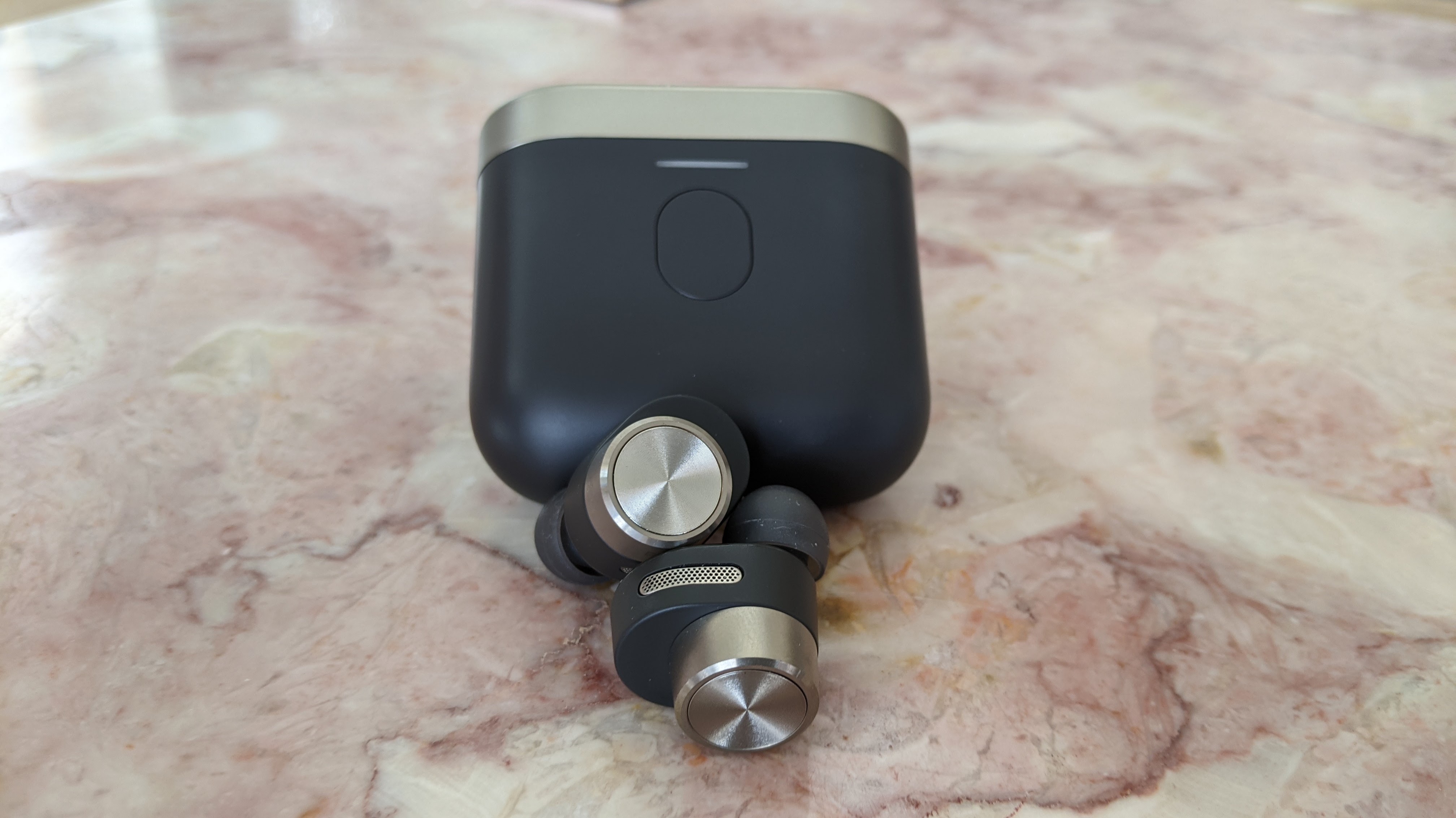Laptop Mag Verdict
The Bowers & Wilkins PI7 is a stellar debut backed by top-tier ANC and sound, though it comes with a steep price.
Pros
- +
Hi-fidelity sound
- +
Exceptional craftmanship
- +
Strong ANC
- +
Charging case doubles as a Bluetooth adapter
- +
Dust- and water-resistant
Cons
- -
Poor battery life
- -
Notable missing features
- -
Very expensive
Why you can trust Laptop Mag
Bowers & Wilkins launched two new pairs of wireless earbuds — the PI5 and PI7 — with the latter serving as the brand’s flagship model. This standout release is the in-ear sibling to the popular PX7, one of the market’s best noise-cancelling headphones, and it possesses its own set of hallmarks. This includes a fancy design, rich sound, robust active noise cancellation, and a surprising feature no one thought to create, until now — a charging case that can also be used as a wireless adapter.
- Our expert picks for the best wireless earbuds, per budget and style
- Check out our Apple AirPods Pro review
- …and our Bose QuietComfort Earbuds review
Like all B&W products, the PI7 doesn’t come cheap at $399, which is surprisingly steep compared to other high-end options. In addition, there are some omissions that, if added via firmware update, could boost its stock. Nonetheless, there’s no denying that the PI7 is an incredible addition to the category and well worth owning if your budget allows.
Bowers & Wilkins PI7: Availability and price
The Bowers & Wilkins PI7 is available directly from B&W and up for pre-order at major online retailers, including B&H and Audio Advice. It is sold in two colors: Charcoal and White. Bundled with the purchase are a charging case, three sizes of ear tips, a USB-C charging cable, a 3.5mm to USB-C cable, and a quick start guide.
These buds are some of the priciest out there at $399, listed higher than the AirPods Pro ($249), Bose QuietComfort Earbuds ($279), and Master & Dynamic MW08 ($299). All three competitors are solid and more affordable alternatives, though if you’re looking for something much less expensive with adequate ANC and dynamic sound, check out the $129 Anker Soundcore Liberty Air 2 Pro or $199 Samsung Galaxy Buds Pro .
Bowers & Wilkins PI7: Design and comfort
B&W is a go-to for attractive audio products and the PI7 showcases the brand’s luxe design pedigree superbly. It’s not just the materials, but the details that make these buds such a stunner.
The PI7 is composed of matte plastic and aluminum, which makes up the protruding metal cylinder that houses the touch panel and resembles a dial. I mean, how crazy would it have been if B&W integrated this feature for volume controls? The buds come with an IP54 rating to protect the high-powered internals from light splashes, rain, sweat, and even dirt. This is a step up from the AirPods Pro’s water resistance (IPX4). Build quality is also exceptional with casing built to sustain the daily abuse that you’ll put these beauties through.
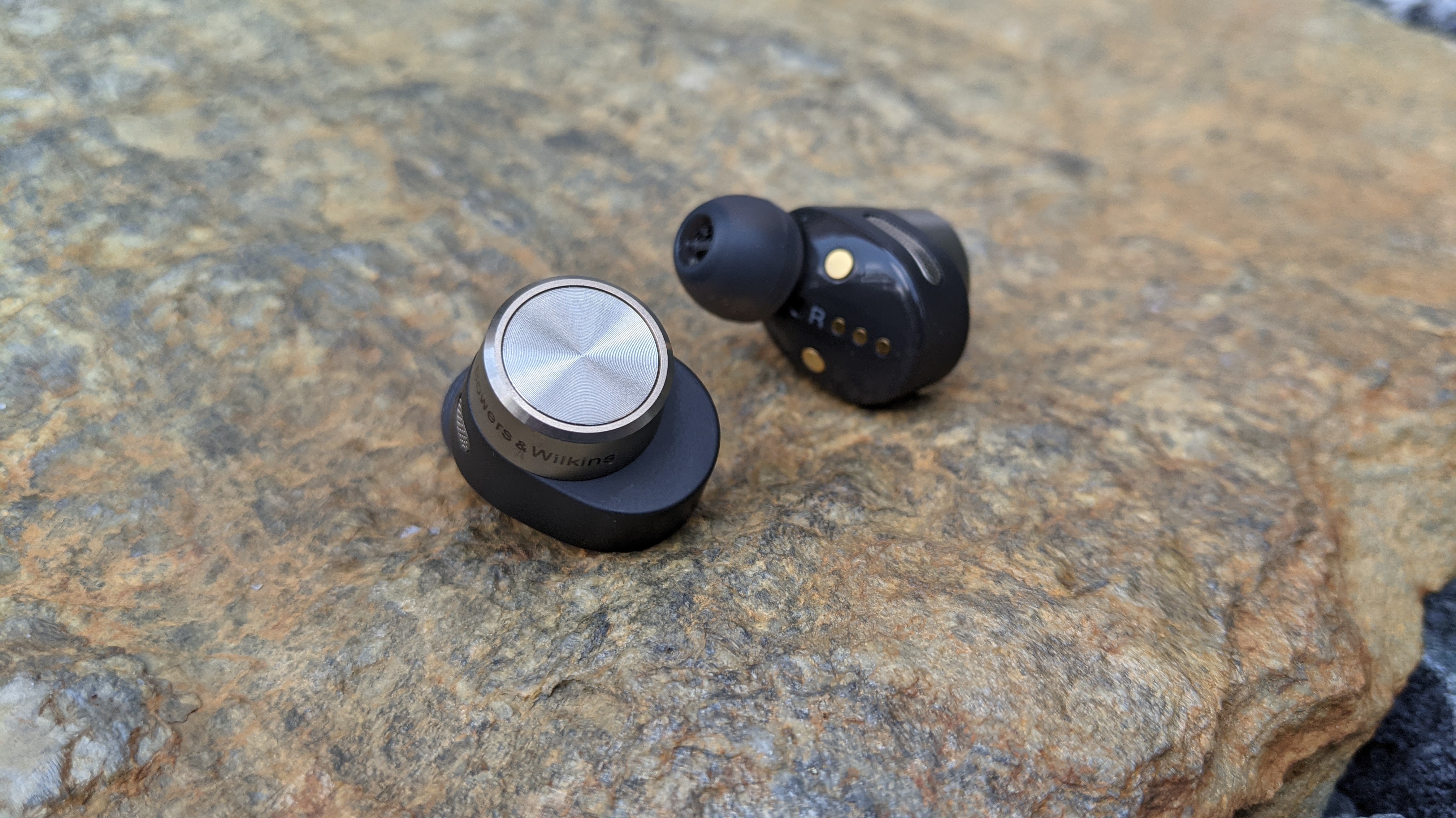
As for appearance, the PI7 isn’t the most discrete pair to wear in public. Some will find it sticks out a bit too much, similar to a hearing aid. Granted, it isn’t as bulgy as the QuietComfort Earbuds, nor does it dangle off the ear like the AirPods Pro. Neat touches like the laser-etched logo around the cylinder component and the air vent at the bottom are much appreciated. The two-tone colorways are sexy too. Something else intriguing are the silicone tips which have a mesh barrier that prevents earwax build up to optimize acoustic performance.
Sign up to receive The Snapshot, a free special dispatch from Laptop Mag, in your inbox.
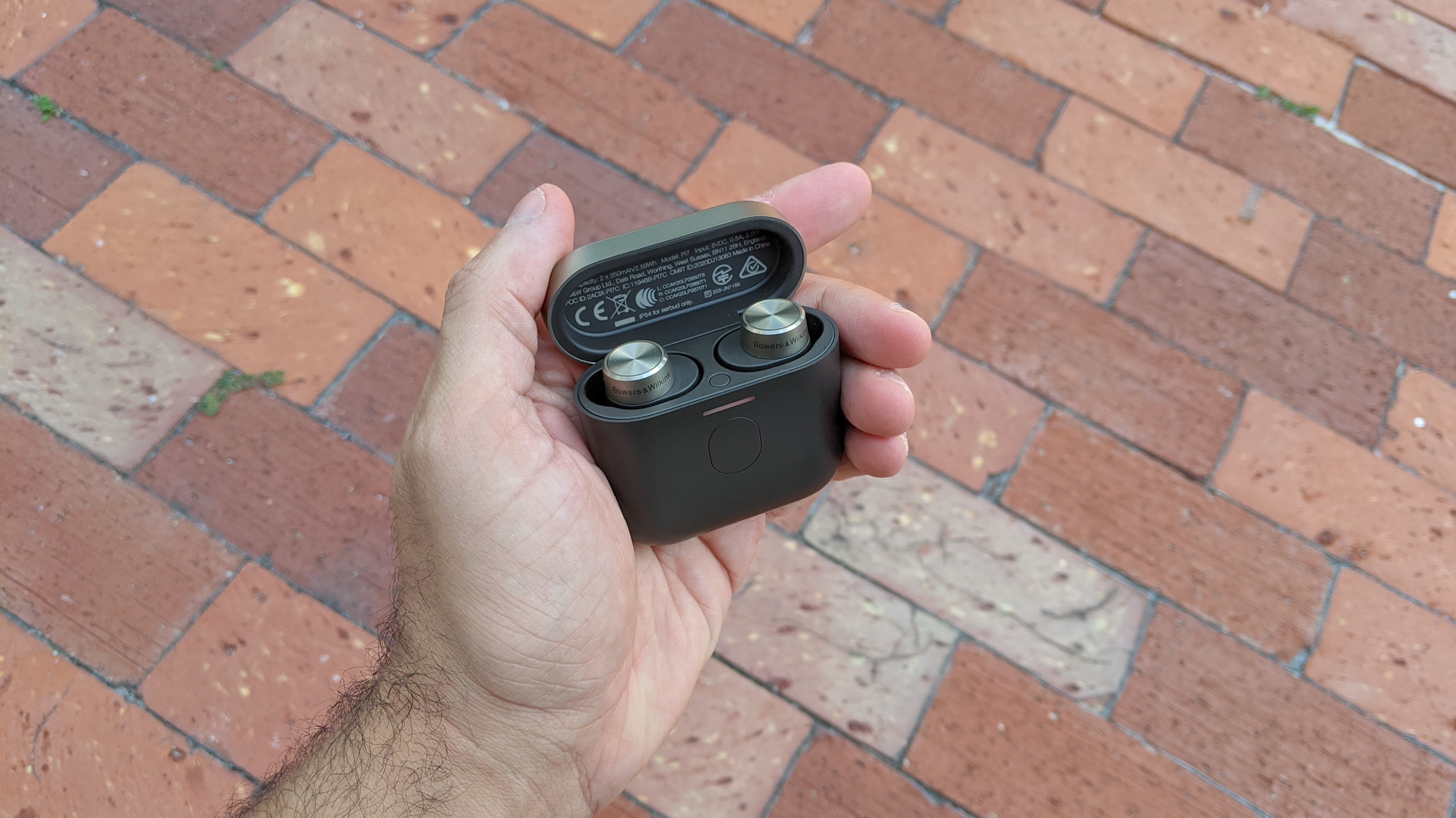
While the charging case maintains the buds’ aesthetic sleekness, it lacks the compactness and durability of the AirPods Pro’s case. B&W’s case is also listed at a heavier weight (2.1 ounces) than Apple’s case (1.6 ounces), yet, ironically, feels lighter in hand. There is a button on the inside to manually enable pairing mode, and a button on the outside to indicate battery levels, though a rumor suggests it will take on a future function in an upcoming software update.

These buds provide moderate comfort, meaning you can use them for an hour or two straight before fatigue sets in. I did notice the elongated sound port applied pressure on the front of my ear (aka the tragus). On the flip side, the port nestles well on the inner ear for enhanced stability. The silicone tips do a decent job as well to create a nice seal around the canal that keeps the buds locked in when moving around.
Bowers & Wilkins PI7: Controls and digital assistant
Touch controls are the primary input and consist of single (play/pause/answer call), double (skip track/end or reject call) and triple taps (previous track), along with a press-and-hold gesture to enable voice assistance (right bud) or ANC (left bud). On-ear detection comes as part of the package to automatically pause music when removing the buds and resume playback when placed back on the ear. Overall, the control scheme was responsive and executed commands with ease.
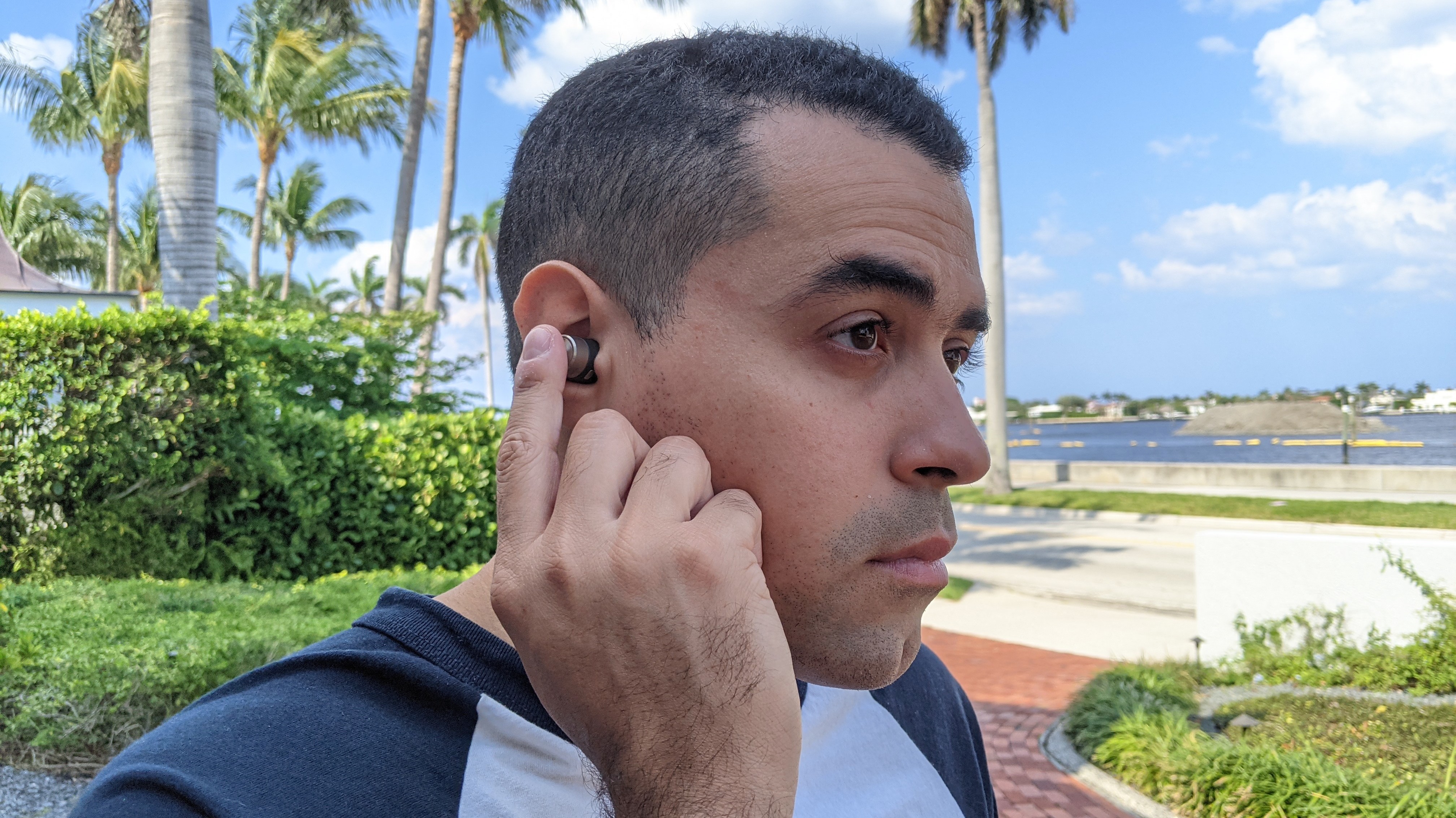
Siri and Google Assistant are both operational on the PI7. My experience with these two voice assistants was serviceable. There was no latency or command misinterpretation. Almost everything I threw at them was met with quick and accurate responses, courtesy of B&W’s powerful six-mic array, which demonstrated excellent speech recognition.
Bowers & Wilkins PI7: Active noise cancellation
When talking ANC on wireless earbuds, nothing beats the QuietComfort Earbuds. Its closest competitor was the AirPods Pro, but the PI7 just killed that argument. These buds have some of the strongest noise neutralization and do a convincing job of blocking out the majority of external sounds, while commendably minimizing noises that are too perceptible to avoid.
Stepping into a rowdy living room, I was pleased with the buds muting all of the family couch commotion and loud action taking place during The Falcon and The Winter Solider finale. Daddy duty was just as gratifying, as my baby boy wasn’t a distraction when riding his electric swing during work hours. Some grunting did enter the soundscape, but not at an alarming level. It was also great to shop peacefully at the supermarket, drowning out chatty shoppers and the terrible ‘90s alternative rock mix blasting in every aisle.
The PI7 performed just as well outside, especially in drafty conditions. Wind resistance was strong, and that annoying whooshing effect produced by most wireless earbuds didn’t prove to be an issue. But, as previously mentioned, not all sounds go silent. Construction tools like a jackhammer, along with high-frequency noises (e.g., ambulance sirens, whistles) will be heard, though none of these are distracting enough to pull you away from what’s currently playing.

There’s also an Auto mode that automatically tweaks noise cancellation based on the amount of noise around you. I found it less effective than manual ANC; voices and high-frequency sounds were very transparent. My guess is B&W included it as a way to offer some neutralization and preserve battery life.
The Ambient Pass-Through mode is stellar and supports 16 levels of adjustable transparency. This is the highest that I’ve seen in the true wireless category. As expected, raising it every level opens up the mics to allow more noise in. Anywhere between levels 4 and 8 is ideal to eavesdrop on conversations or hear what else is happening around you. You’re welcome to listen at max level, but it’s ridiculously powerful, to the point where you can hear people conversing across the street, though high-frequency noises sound painful.
Another tidbit worth mentioning is that ANC and Ambient Pass-Through can be enabled at the same time, which initially led me to think that both modes blend together, similar to the QuietComfort Earbuds. My intuition was right, as B&W confirmed. What’s the point of having both turned on? In short, the technologies work together to make ambient noises more distinguishable and less harsh on your ears, and the results are surprisingly good.
Bowers & Wilkins PI7: Audio quality
Sound is a staple for B&W, and they went all-out to give the PI7 the finest audio representation. Not only do these buds boast Dual Hybrid Drive units with individual amplifiers for each driver, but they also support 24-bit sound and Qualcomm’s latest aptX Adaptive codec, awarding you lossless wireless sound when streaming music on hi-res platforms like Qobuz or Tidal. What you get is one of, if not, the best-sounding wireless earbuds to date.
The low end is well balanced and bumps hard, as exemplified in contemporary music genres. The bass groove on Digital Underground’s “The Humpty Dance” had an energetic bounce to it, thanks to a monstrous kick drum that unapologetically knocks hard. Much of that vibrancy carried over into rock records like Linkin Park’s “Papercut.” The metallic riffs raised my adrenaline levels and blended well with the contorted and warped vocals. It was satisfying to hear how well these buds reproduced bass without any distortion or veiling mids and highs.

Speaking of which, highs sound amazing on the PI7 and are felt most when indulging in Jazz classics. The melodic piano play on Duke Ellington’s “The Feeling of Jazz” was audibly serene, while the splashing cymbals were prominent throughout the entire recording. Etta James’ soaring voice on “At Last” exuded power and passion, showcasing the buds’ exceptional range.
The PI7 also handles complex recordings like a pro, revealing imperfections and subtle nuances you likely wouldn’t hear on other models. I can tell you that the cowbell on Blue Oyster Cult’s “(Don’t Fear) The Reaper” is more emphasized, but there is greater satisfaction sharing how clear the piano note accidentally played at the start of The Police’s “Roxanne” sounds.
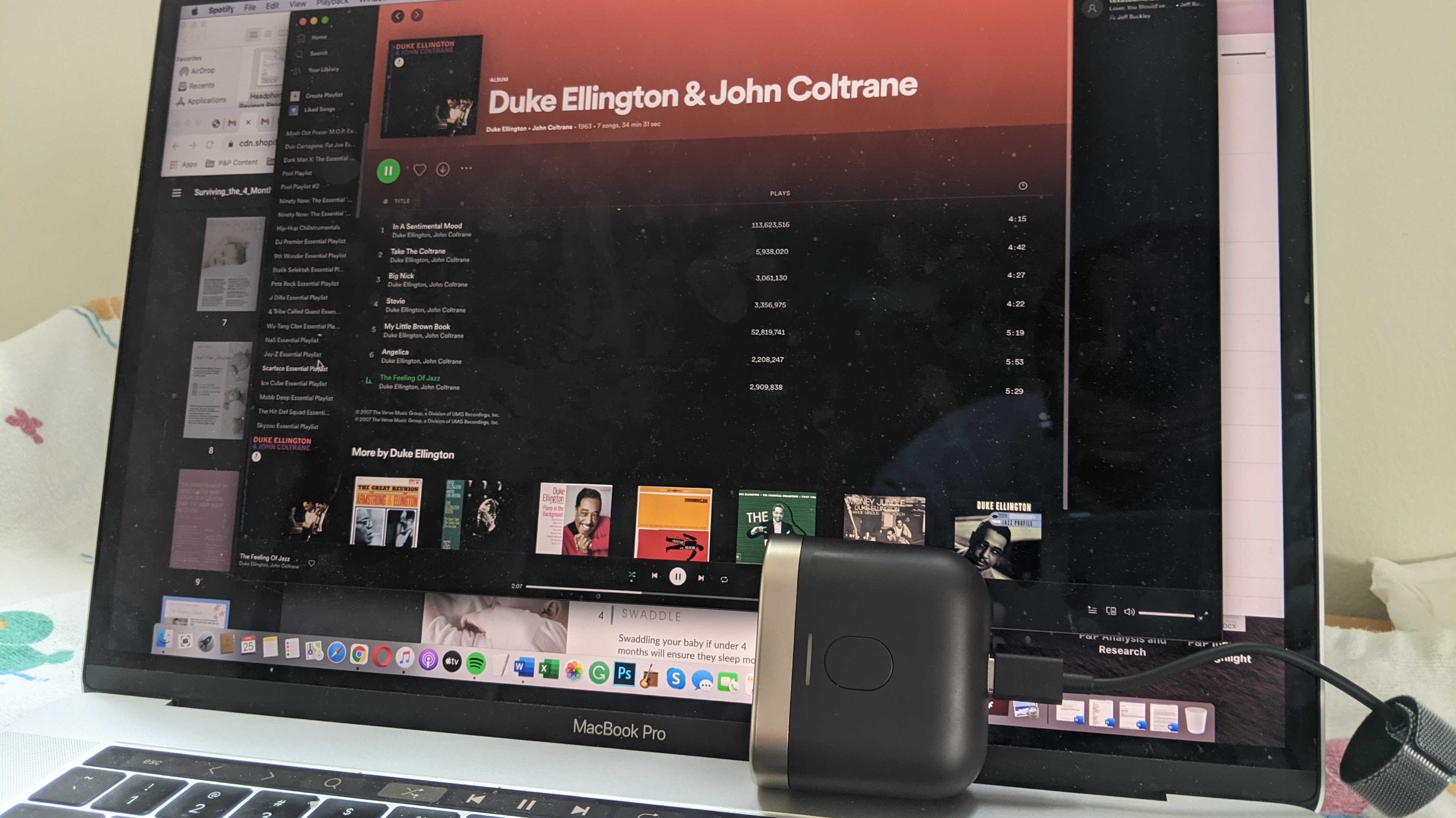
Another factor that elevates the PI7’s audio performance above the rest: the charging case. B&W figured out a way to have its charging case double as a wireless adapter for the buds, so you can plug it into any compatible analog audio output (e.g., airplane jack, iPod Classic, laptop, USB turntable) and stream music in aptX. You don’t have to worry about the sonics taking a dip either because technology manages to retain the PI7’s crispy highs and punchy bass.
Bear in mind that most of my testing was done through regular streaming services like Spotify, as well as Apple Music, though I tested a few tracks on Qobuz and was even more stunned.
Bowers & Wilkins PI7: App and special features
The B&W app doesn’t have a vast variety of features like Jabra or Sony’s offerings, but there is enough here to improve the user experience. It’s simple to use with functions and settings spread across four different screens. You’ll find battery level indicators for both earbuds and the charging case right at the top of the home screen, along with toggle controls for both Noise Cancellation and Ambient Pass-Through. This is also where the aforementioned Auto mode can be enabled, along with the slider to adjust transparency levels.
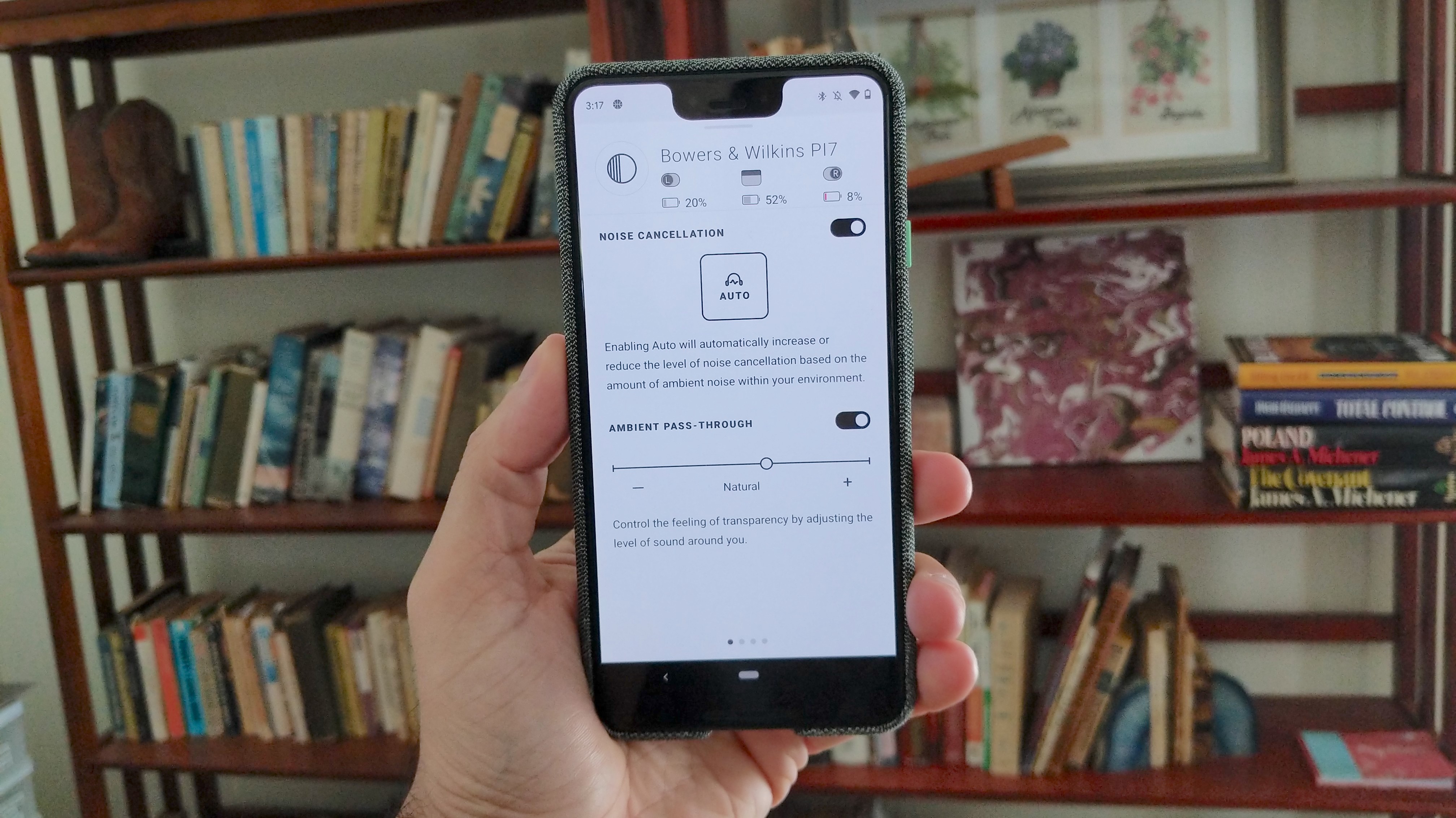
The other major feature is Soundscapes, which has six different profiles that mask the noise around you with sounds of nature. It’s not like you can’t find this on other companion apps, though the difference is that B&W’s profiles sound better and reproduce effects extremely well.
Rounding out the app is a toggle control for on-ear detection and firmware support. Oddly, there are some features missing on the PI7 that seem to be exclusive to the PX7, including a voice prompt setting and Standby Timer that places the buds in sleep mode when inactive.

Two notable features that didn’t make the cut: an EQ and Find My Buds function. Luckily, B&W’s default sound profile complements all music genres, but not having a way to locate your misplaced or lost buds is a shame.
Bowers & Wilkins PI7: Battery life and charging case
The AirPods set the industry-average time for battery life when launched, but over time, competitors have stepped up to surpass Apple’s playtimes. It pains me to say that the PI7 is not one of those models.
At 4 hours with ANC on, this is lower than the AirPods Pro (4.5 hours) and QuietComfort Earbuds (6 hours). That number decreases by about 30 minutes when taking volume and streaming into account. No sleep mode means the buds will stay powered on when connected and not in use. I also noticed that the discharge times for each bud is unequal. According to B&W, the buds operate on a “master/slave relationship,” which is dynamically assigned. The simpler explanation is that whatever bud you remove first from the case acts as the master unit and consumes more power.
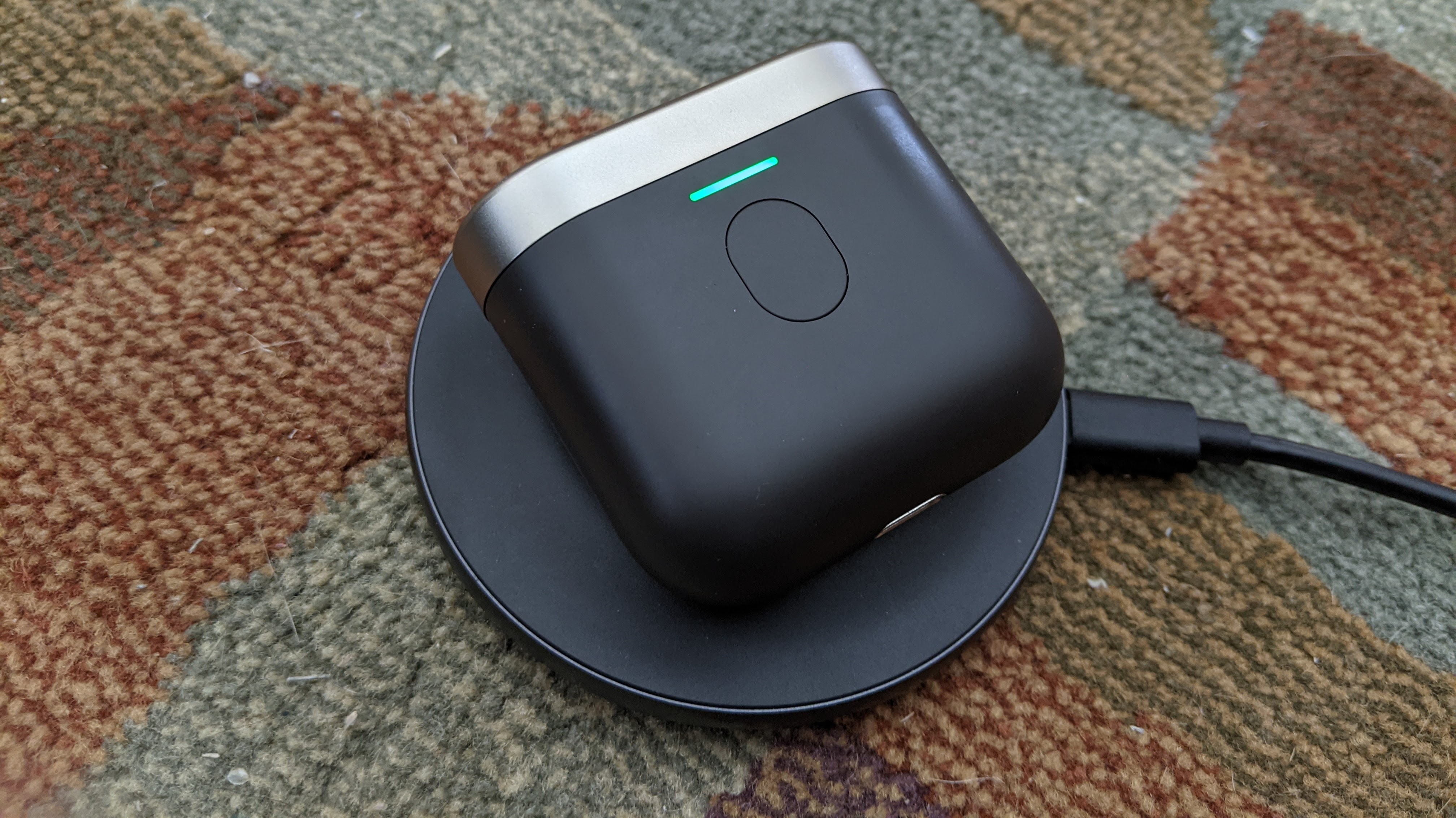
B&W hasn’t disclosed the playtime with ANC off, but my testing saw a 30-minute increase. Another positive is that the buds come near-fully charged (90%) right out of the box.
The charging case is also a letdown, holding only 20 hours when fully charged. That is 4 hours less than the AirPods Pro case (24 hours total) and 22 hours less than the MW08 case (42 hours total). At least it’s more than the 18 hours generated by the QuietComfort Earbuds case. To supplement the low playtimes, B&W added wireless charging support and quick charging to give you 2 hours of use on a 15-minute charge.
Bowers & Wilkins PI7: Call quality and connectivity
Considering its excellent mic performance, I expected more from the PI7 as a calling headset. Not to say that it’s bad or even disappointing, as it’s sufficient for jumping on calls when necessary. It’s just not AirPods Pro or QuietComfort Earbuds quality. Talking to the missus when watching the baby at home, she heard me fairly clearly, though I wasn’t too fond of how low the volume was on her end. When answering her calls outside, she noticed some crackling and said my voice was cutting out due to wind interference. Performance cleared up when speaking in less drafty and low traffic settings.
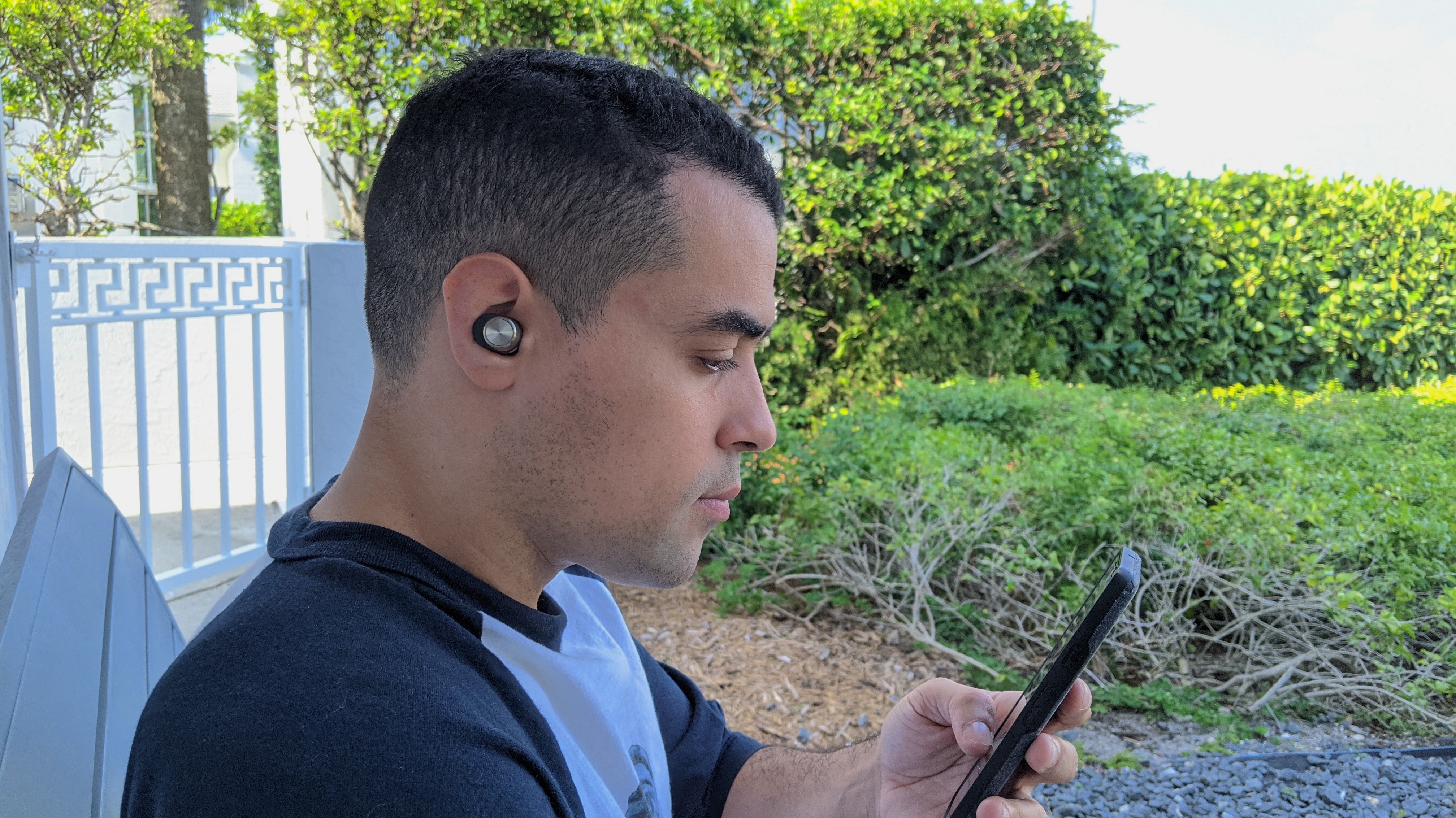
The connectivity on these buds is hit or miss. They will automatically appear on the available devices list when opening the case. Repairing is even quicker with the PI7 automatically connecting to your last recognized device. There is also zero latency when streaming. Unfortunately, the range is terrible, as audio began to stutter when teetering around the 15-foot mark no matter what device I streamed from.
For a newer release, I figured wireless features like Google Fast Pair and multipoint technology would have been a given. That was a poor assumption, as neither is available.
Bowers & Wilkins PI7: Verdict
If luxury wireless earbuds are your thing, then the Bowers & Wilkins PI7 is a must-own. It looks handsome, sounds excellent, and delivers grade-A noise cancellation that is only second to the QuietComfort Earbuds. Everything from the drivers to the codec support shows that B&W didn’t skimp on audio quality. The company also flexed its ingenuity by bringing a first to the category: a charging case that can plug into any audio jack and retransmit audio to the buds.
The PI7 has many bells and whistles, but it doesn’t have all of them, which some may feel doesn’t justify its expensive price. Battery life and connectivity should be better than what you get. Also, the lack of common functions (sleep mode) and certain features (EQ, Find My Buds) are exclusions that would have rounded out the user experience.
You can save money and enjoy either great sound from the AirPods Pro or best-in-class ANC from the QuietComfort Earbuds, but the PI7 gives you a wonderful mix of both. You just have to pay the premium, and it’s a high one.
Alex Bracetti writes about all things related to audio at Laptop Mag. From insightful reviews of Sony earbuds to hands-on experience with the Beats Studio Pro, Alex covers everything you need to know in order to buy the best pair of headphones or earbuds. Alex has also written about speakers and audio apps. Outside of Laptop Mag, Alex's work has appeared in our sister site Tom's Guide.
